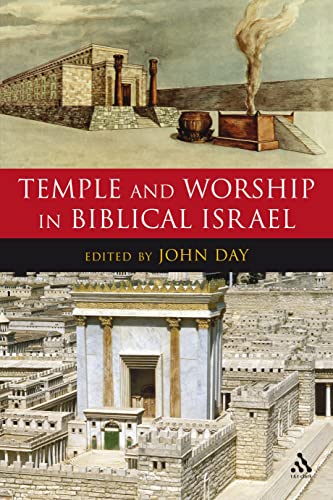TEMPLE AND WORSHIP IN BIBLICAL ISRAEL, LHB/OTS 422
Written by John Day (ed.) Reviewed By Walter L. McConnell IIIThe twenty-three essays compiled in this book were originally delivered as papers to the Oxford Old Testament Seminar between 2001 and 2003. As should be expected of such a collection, many of these papers are of an extremely specialist nature and some of them are only tenuously related to worship or the Jerusalem temple. For this reason, those looking for an introduction to the temple and worship in Israel are likely to be disappointed. Even so, the essays provide first-rate research and excellent bibliographies that many students will find useful for their studies. That a number of the essays view ‘biblical Israel’ as a literary construct that may not correspond to the historical nation will undoubtedly make some readers uncomfortable.
The book is divided into three parts. The first section is made up of three essays pertaining to ‘Temples and High Places in Israel and the Canaanite World’. Here Mark S. Smith, ‘Like Deities, Like Temples (Like People)’, investigates the worship of Baal in literary rather than actual temples; Elizabeth Bloch-Smith, ‘Massebot in the Israelite Cult’, examines criteria archaeologists should use to identify standing stones; and Simcha Shalom Brooks, ‘From Gibeon to Gibeah: High Place of the Kingdom’, regards what archaeology has unearthed with regard to two important Benjamite cities during the time of Saul. As little is said here about temples or worship in Israel, many readers will wonder how these chapters found their way into this book.
The articles in the second section, ‘Temple and Worship in the Old Testament’, will be of more use to students of the Bible. Victor Avigdor Hurowitz visits ‘Yhwh’s Exalted House’ to find, as the subtitle informs us, ‘Aspects of the Design and Symbolism of Solomon’s Temple’. This is followed by several articles that focus on the prophetic understanding of the temple and worship. John Barton writes on ‘The Prophets and the Cult’, concluding that Old Testament prophets had different opinions about the validity of the cult’, H. G. M. Williamson examines ‘Temple and Worship in Isaiah 6’. Paul M. Joyce finds a combination of ‘dream and reality’ (147) in the description of ‘Temple and Worship in Ezekiel 40–48’. Jill Middleman identifies ‘Divine Reversal and the Role of the Temple in Trito-Isaiah’.
Worship themes in Deuteronomy are investigated next. Anselm C. Hagedorn, provides a social-scientific investigation in, ‘Placing (a) God: Central Place Theory in Deuteronomy 12 and at Delphi’, Ian Wilson questions whether the ark as portrayed in Deuteronomy is ‘Merely a Container?’, and determines that it is clearly associated with the divine presence. John Day asks, ‘Whatever Happened to the Ark of the Covenant?’, and concludes that it was probably destroyed in 586 BCE.
Three chapters investigate several aspects of worship in the Psalms. Philip S. Johnston examines the evidence for ‘Ordeals in the Psalms?’ and finds that it is lacking. Stuart Weeks’ investigation of ‘Wisdom Psalms’ concludes that the criteria generally used to identify them are actually of little help, but gives his opinion about a number of psalms that relate to wisdom. In ‘The Zion Tradition and the Editing of the Hebrew Psalter’. Susan Gillingham contends that the editors of Psalms belonged to Temple circles and their editorial activity was influenced by its liturgy.
In the final two articles in this section. Deborah W. Rooke outlines the ‘The Day of Atonement as a Ritual of Validation for the High Priest’, and John Jarick finds the Chronicler’s description of the temple to be unique in, ‘The Temple of David in the Book of Chronicles’.
Part Three follows the themes to a later period in history, offering seven articles touching on ‘The Temple in Late Second Temple Judaism and in the New Testament’. Covering the period between the testaments. C. T. R. Hayward introduces ‘Understandings of the Temple Service in the Septuagint Pentateuch’. Michael A. Knibb looks at ‘Temple and Cult in Apocryphal and Pseudepigraphal Writings from Before the Common Era’, George J. Brooke examines ‘The Ten Temples in the Dead Sea Scrolls’, and Molly M. Zahn reveals ‘New Voices, Ancient Words. The Temple Scroll’s Reuse of the Bible’ The essays are completed with three articles on the temple in the first century CE: Martin Goodman. ‘The Temple in First Century CE Judaism’. Christopher Rowland, The Temple in the New Testament’, and Larry J. Kreitzer, The Messianic Man of Peace as Temple Builder Solomonic Imagery in Ephesians 2:13–22’.
The book is completed by an extensive Index of References containing both biblical and non-biblical texts and an index of authors. Although sew will feet the need to purchase this book for their own use, many will find it useful for specific studies.
Walter L. McConnell III
Walter L. McConnell III
OMF International
Singapore







